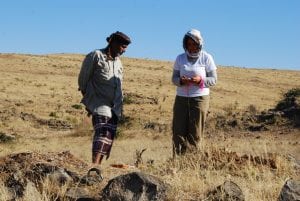PI Joy McCorriston and Abigail Buffington presented two papers on ASOM research at the Seminar for Arabian Studies, this year in Leiden (the Netherlands). McCorriston presented a paper on monuments in Dhufar with an emphasis on boat-shaped graves the team excavated at D114 this past field season. Buffington presented the results of the settlement survey along with preliminary spatial analysis. Additionally, team member Joe Roe presented survey results from his latest field season in eastern Jordan.
Author: buffington.27
Hyrax Group Reunites in Happy Valley!
Annalee Sekulic recently traveled to Pennsylvania State University where she met with (now Professor) Sarah Ivory. The goal of the work weekend was to begin disaggregation of the Hyrax middens collected during the February 2018 and Autumn 2018 field seasons. She sorted, sized, and smelled a new step of the process which will assist her in producing her comparative macrobotanical data set. Sarah coached and mentored Annalee with her undergraduate senior
thesis and post-graduation options!
Undergraduates in Fieldwork
Two OSU undergraduates made their first trip to Oman last autumn. Drew Arbogast spent intensive time working with the Oman Botanic Garden collecting botanical samples for his phytolith reference project. Annalee stayed for the long-haul collecting reference samples, participating in hyrax-midden hunting, and acquiring more than her fair share of dust inhalation during excavation. Both students agree that their time in Oman was a transformative experience and now have a love for camel meat.

Drew and Abby at the Oman Botanic Garden with Zawan Al Qassabi, the Herbarium Specialist. Annalee in the course of hyrax midden survey
Second Archaeological Field Season in Dhufar!
This fall, the ASOM team returned to Oman for another field season focused on survey and excavation of the plateau and escarpment regions surrounding and within the upper drainage of the eastern Wadi Darbat. During October, Abigail Buffington, Kyle Olson, and Joesph Roe conducted a systematic randomized survey of the plateau west of Jibjat and conducted targeted survey of remotely sensed locations in the escarpment surrounding the towns of Halqut and Yur. Multiple additional team members joined our small core team on a few days. Ali Ahmed Al Kathiri, the ASOM project’s representative from the Dhofar office of the Ministry of Culture and Heritage, provided our team with wonderful insight into the terrain, environment, and landscape history, as well as aiding our hypothesis generation for settlement chronologies and structure function.
Following this survey season in November, Annalee Sekulic joined Abby, Kyle, and Joe to form the excavation team, and we excavated a small number of the 50 new surveyed sites. Our team successfully trenched some of the structures at a very large settlement site, Mthbon, to the east of Halqut, as well as a meaningful sample of structures at two smaller sites in the survey region.
This component of the field research was generously supported by the National Geographic Society’s Early Career grant and the Penn Museum.
#insidenatgeo
Termite Mounds again
We all got very interested in termite mounds again this season. While a draft article using data from Abby, Kyle, and Konstantin’s studies is circulating, we probed more mounds. Konstantin elected to trench and sample seven mounds, including some at D150 and a lone mound at the northern edge of the plateau. Here our hard-working Bengali helpers are at it yet again—we couldn’t do the project without them! We observed that there is a belt of termite mounds (marking formerly forested areas) that seems to correlate negatively with areas where exclosures and settlements are most dense. Can it be that the grasslands in the escarpment were more fully developed earlier?
Excavations for monument chronologies
One of the enduring challenges has been the chronology of these monuments, few of which have ever been examined by archaeologists. Are all these monuments the same age? With Dr. Kimberly Williams, Joy McCorriston and four Omani students excavated two graves at D114. We noted that these tombs do not always contain much (or any?) human bone and that they seem to favor the flat surfaces of abandoned corrals for their placement. Stay tuned for the dates.
ASOM Field Team Joined by Omani Students
Four students from the Master’s program at Sultan Qaboos University (Department of History) joined the field team. They flew from Muscat, put in long days excavating, and toured our newly recorded rock art sites. We worked hard through the evenings but had great fun too. With a blended celebration, we enjoyed the hospitality of ‘Abdalrahman’s family and American Thanksgiving. Grilled goat, mashed potatoes, and Bengali curry. Then…back to work!
Oman Botanic Garden Visits Dhufar!
A team of five researchers from the Oman Botanic Garden, led by Director Annette Patzelt, as well as Edinburgh Botanic Garden’s Tony Miller, joined us in Dhufar this year! Annette and Saif al-Hatmi led the botanical surveys in the plateau, near escarpment and along the wadis. The results of this research will aid in the ASOM objectives by providing clarification on the modern ecological communities and how these plant associations relate to the paleoecology proxy archives collected from the hyrax middens and termite mound paleosols.
National Geographic Society Early Career Grant
ASOM graduate research associate, Abigail Buffington, has been awarded a National Geographic Society Early Career grant for the Fall 2018 ASOM field season. Her grant proposal emphasized the field objectives of documenting the spatial and chronological dimensions of settlement history in Dhufar. Buffington and co-director, Kyle Olson, will be conducting a survey and small-scale excavation.
@insidenatgeo
Publication on Wood Charcoals from Shakal
ASOM graduate research associate Abigail Buffington recently published a paper with ASOM project PI Joy McCorriston on the anthracology from the site of Shakal, a settlement site in eastern side of Dhufar, Oman.
This paper describes and compares the charcoal assemblage patterns from the archaeological excavation at the site of Shakal to the historical ethnography of Dhufar pastoralists’ wood resource use.
Find the paper here.








